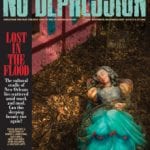Laura Veirs – In through the out crowd
Offstage, a couple of hours before her show, Veirs was friendly but reserved, a bit cautious. Onstage, she wielded an electric guitar better than most geologists — she cut her teeth in a punk band and cites among her influences Built To Spill leader Doug Martsch (an Idaho native who spent time in Seattle) and Neil Young — but she isn’t the most natural performer. The spectacle of her dropping to her knees in her summery red dress and sandals to induce feedback from her guitar amp was a charming bit of post-grrrl power, but a bit in which she and her band, the Tortured Souls, played the new album’s “Spelunking” with the house lights turned off, piercing the darkness with beams from their miner’s helmets, seemed forced.
For all that, Veirs is a determined artist beneath her wallflower exterior. Her self-released, self-titled 1999 debut was also independently recorded — just her and her guitar. She says it took her three hours to complete. The 2001 follow-up Triumphs & Travails Of Orphan Mae, with its taste of dirty blues and early country, pointed her toward the processed Americana sound patented by Bill Frisell. It was a concept album about a young woman on her own out west (“I can’t feel secure about my work unless there is an overarching theme,” she says). Frisell showed up on 2003’s Troubled By The Fire (released by Bella Union, a British label) as part of a Seattle posse including banjo player Danny Barnes, saxophonist Amy Denio and violinist Eyvind Kang.
Frisell helped Veirs get signed to Nonesuch, which doesn’t ordinarily sign “new” artists like her. “It was definitely a long shot,” Veirs recalls. “I didn’t think it would happen. I didn’t even think I was on their map. Actually, though, when they made an offer, it was a hard decision for me. I didn’t know whether Nonesuch would do as well for me in Europe as Bella Union. But so far it looks great.” Indeed, shortly after the Chicago show, Veirs and the Tortured Souls embarked on an extensive month-long swing through Europe.
Year Of Meteors, Veirs’ first real band album, departs from previous efforts in having been recorded live in the studio with overdubs. With Veirs alternating between acoustic strumming and electric scratching (“Guitars can’t help but sing/Can’t help but ring,” she muses on the Carbon Glacier track “Ether Sings”), Steve Moore deriving more color from electric piano than most keyboardists, Karl Blau providing muscle and charisma on guitar and bass, and Martine laying on the squiggles and gurgles and squeaks in addition to beating out striking off-rhythms and swinging patterns, the Souls are able to go off in any direction at any time. They have been playing together long enough now to make those shifts seamless.
A producer whose clients have ranged from the great jazz saxophonist Sam Rivers to twisted roots artist Jim White to Mylab (his own duo with keyboardist Wayne Horvitz), Martine is as integral to Veirs’ sound in a live situation as he is in the studio. As a drummer, he pushes the music forward and gives it lift even during its quieter moments. But it’s as an aural auteur that he most distinguishes himself.
“The one thing Tucker has impressed on me is to trust your feelings in the studio, to go with what you’ve got and not second-guess yourself,” says Veirs. Though they have worked together for years, this was the first time she had gone on tour with Martine (a Nashville native whose father, Layng Martine Jr., wrote Elvis Presley’s 1977 hit “Way Down”, a country #1 the day Presley died). When she says, “I don’t really want to be a solo artist,” you can understand why. As revealed in video clips on her website showing the band “skipping rope across Europe,” she thrives on the company as well as the sound.
Since telling her Nonesuch biographer that Year Of Meteors is a road album with its recurring themes of travel and motion, and telling an interviewer that it’s about the sometimes meteoric ups and downs of a band on tour, Veirs has come to regret spelling things out that way. Among other things, it guaranteed people would ask her to peel away the mysteries of her poetry and reveal the real-life details in the songs. She has, however, acknowledged the lasting impact of touring America with her parents for a year in a “hippie van” when she was 11. Both teachers, they home-schooled her. She kept a journal, schooling herself as a writer and observer.
On the cover of Year Of Meteors, she is photographed on the road — or, actually, on the street. Gazing straight at the camera, lit from behind by sunlight, her face warmly illuminated by artificial light, she radiates a Mona Lisa-esque suggestiveness. The closeup was taken by San Francisco photographer and video artist Autumn de Wilde, whom Veirs employed after researching the field and looking through de Wilde’s shots of subjects including the late pop artist Elliott Smith.
Other portraits of Veirs from these sessions (which can be seen on the Nonesuch website and at lauraveirs.com) create an entirely different image for the singer. Gone is the librarian look she says she likes. In its place is a playful, glamorous vision in which she is seen grinning in a sleeveless ’60ish getup topped by a newsboy’s cap pulled down over her eyes to set off her cheekbones. In these photos, she could be mistaken for actress Lili Taylor of indie movie and “Six Feet Under” fame.
“She really took me out of my element, which was really fun,” says Veirs. Though she was now comfortably back in her element with her Tortured Souls mates, one suspects her continued success will have her stepping out again, and soon.




